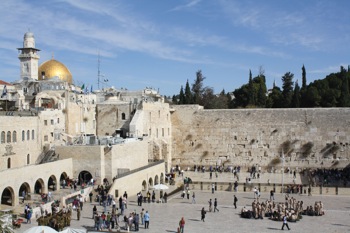
Walking up to the Western Wall, I knew I was surrounded by the truly devoted. The completely reverent attitude of those around me made it obvious that what looked like just another portion of a stone wall meant so much more to the Jewish religion and culture.
“This is the most holy place of the Jews,” said Yehuda Ben Baruch, certified tour guide of Israel. “We do this because we can still feel the power of God here.”
Run by the Orthodox Jews, the Western Wall is revered as the only remains of the Holy Temple, since part of the wall dates from 19 B. C. at the end of the Second Temple period. In concordance with the Jewish tradition a barrier divides the site into sections for women and for men. Most of the visitors wore traditional Orthodox clothes with black dresses for women and skullcaps for men.
In the women’s section, people swayed as they read aloud the Torah with great zeal or sat meditating in a chair close to the wall. As I drew closer, I realized every crack and crevice of the wall was overflowing with tiny folded pieces of paper upon which visitors had written prayer requests.
Peaking over the wall, the golden glint of the Dome of the Rock reminded me that more than one religion looked at this small area as the focus of their beliefs. While I was there, one of the sung Muslim calls to prayer sounded from over the wall and mixed with both Christian church bells and Jewish spoken prayers.
For a few moments, the three very different religions shared a very touching harmony by the Wailing Wall.
For more information:
Israel: They call it the “Jesus boat”
Israel: At faith’s door
WEB EXCLUSIVE: Yad Vasheem, the Holocaust Museum









